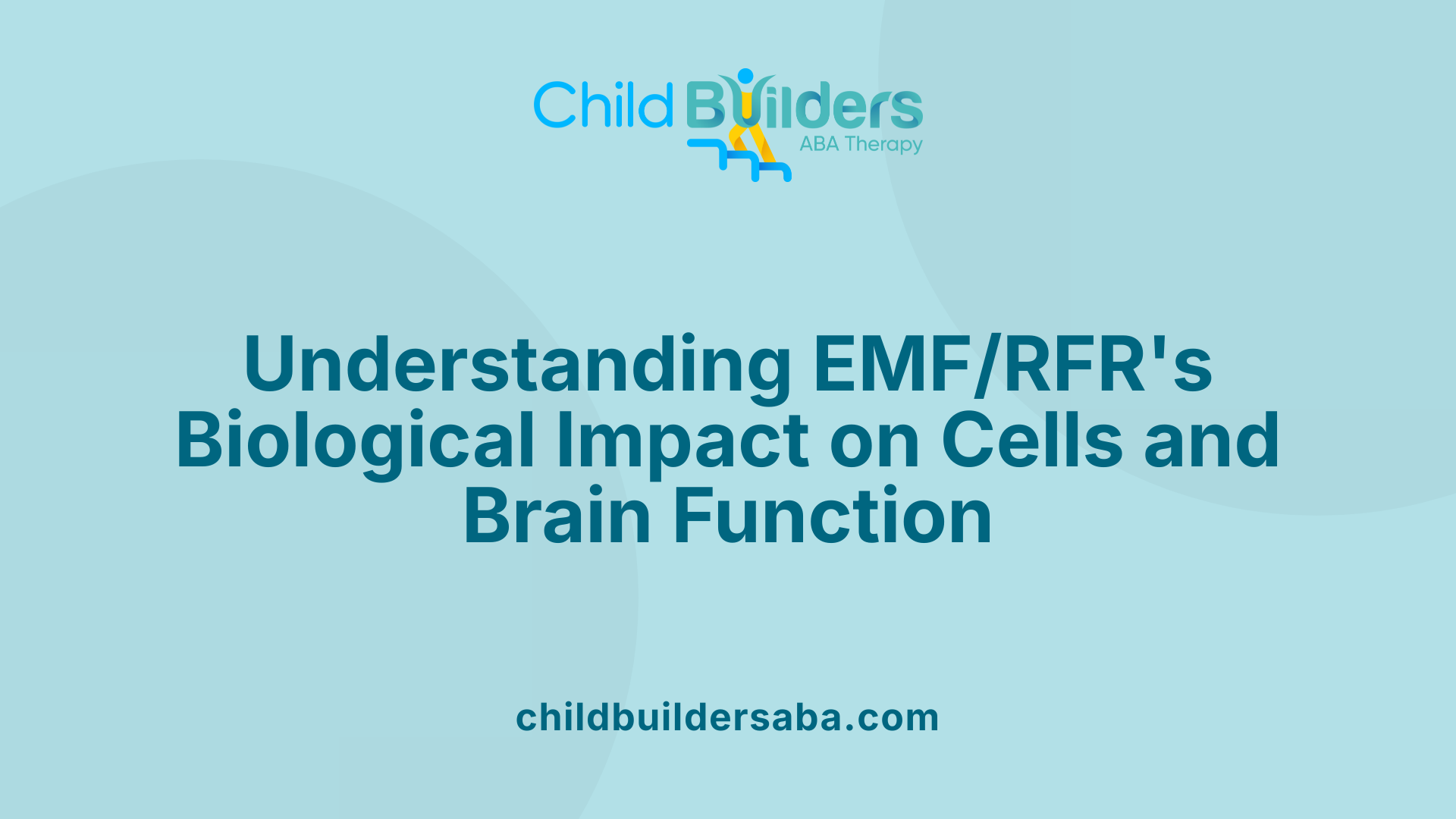Can EMFs Cause Autism?

Exploring Environmental Influences on Autism
The increasing prevalence of autism spectrum disorders (ASDs) over recent decades has prompted scientists and health professionals to examine various environmental factors that might contribute to its rise. Among these factors, electromagnetic fields (EMFs), particularly radiofrequency radiation (RFR), are gaining attention due to their widespread presence and biological effects that parallel some features observed in ASDs. This article synthesizes current research findings, biological mechanisms, and epidemiological data to evaluate whether electromagnetic exposure could be a contributing factor to autism.
Biological Impacts of EMF/RFR on Cellular and Neural Function

Oxidative stress and free radical damage
Research indicates that electromagnetic frequency (EMF) and radiofrequency radiation (RFR) exposures can induce oxidative stress within cells. This stresses the importance of antioxidants like glutathione, which tend to be deficient in individuals with Autism Spectrum Conditions (ASCs). Free radical damage to cellular components such as lipids, proteins, and DNA can contribute to the neurodevelopmental disturbances observed in ASD.
Cell membrane lipoxidation and mitochondrial dysfunction
EMF/RFR exposure has been associated with peroxidation of cell membrane lipids, leading to cell damage. Mitochondrial dysfunction, another documented feature in ASCs, can disrupt energy production and increase oxidative stress, exacerbating neurodevelopmental issues.
Immune system disturbances
Altered immune responses, including immune system disturbances, have been observed in people with ASCs. EMF/RFR may influence immune signaling pathways and contribute to neuroinflammation, potentially impacting brain development and function.
Alterations in electrophysiological brain activity
Electrophysiological disturbances, such as dysregulation of brain oscillations, have also been linked to ASCs. EMF/RFR exposure can affect electrophysiological functions, de-tuning neural networks, and possibly worsening behavioral symptoms.
What are the potential health effects of electromagnetic field (EMF) exposure?
While EMF exposure at common environmental levels is considered generally safe according to current scientific consensus, some studies suggest it may induce biological effects such as increased oxidative stress and cellular damage. These effects might influence neural functions, blood-brain barrier integrity, and autonomic nervous system regulation. The possibility of long-term health concerns like increased risks for certain cancers and neurodevelopmental disorders continues to be explored.
Can electromagnetic fields (EMFs) influence neurological function?
Yes, EMFs can affect neural activity by altering neurotransmitter levels, disrupting synaptic functions, and impacting gene expression related to neural health. They may induce neurobiological changes such as demyelination and synaptic remodeling, which can influence cognition and behavior.
Is there scientific evidence linking electromagnetic field (EMF) exposure to autism spectrum disorder (ASD)?
Direct causative links remain unconfirmed; however, emerging evidence suggests EMF/RFR may produce biological effects similar to those seen in ASD, including oxidative stress and immune disturbances. Some epidemiological observations correlate higher environmental EMF/RFR exposure with increased neurodevelopmental disruptions, warranting further research.
| Aspect | Impact | Details |
|---|---|---|
| Oxidative stress | Cellular damage | Free radicals overwhelm antioxidants like glutathione |
| Mitochondrial dysfunction | Energy deficits | Impaired energy production affecting neural development |
| Immune disturbances | Neuroinflammation | Altered immune responses related to neurobehavioral symptoms |
| Electrophysiological alterations | Neural network dysregulation | Changes in brain oscillatory activity associated with behavioral features |
This compilation of data underscores the potential biological impacts of EMF/RFR on neural and cellular health, emphasizing the need for ongoing research and reconsideration of public safety standards.
Epidemiological Trends and Emerging Concerns
 Over recent decades, the prevalence of autism spectrum disorders (ASDs) has dramatically increased. From about 4-5 cases per 10,000 children in the early 1980s, recent data shows approximately 1 in 500 children are diagnosed with ASD. This surge has sparked concern and prompted investigations into environmental factors that may contribute to the rising incidence.
Over recent decades, the prevalence of autism spectrum disorders (ASDs) has dramatically increased. From about 4-5 cases per 10,000 children in the early 1980s, recent data shows approximately 1 in 500 children are diagnosed with ASD. This surge has sparked concern and prompted investigations into environmental factors that may contribute to the rising incidence.
One prominent area of focus is the possible connection between the increase in autism cases and heightened exposure to electromagnetic fields and radiofrequency radiation (EMF/RFR). Human exposure to RF radiation has become almost ubiquitous over the past 20 years, primarily due to widespread wireless technology and electronic devices.
Research suggests that EMF/RFR may exert biological influences similar to the physiological abnormalities observed in individuals with ASCs. These include oxidative stress, free radical damage, deficiencies in antioxidants such as glutathione, and cellular disruptions like mitochondrial dysfunction and immune disturbances. Moreover, EMF/RFR exposure has been linked to increased intracellular calcium levels, lipid peroxidation of cell membranes, and impairment of the blood-brain barrier—all phenomena that are also documented in ASD pathophysiology.
Fetal and neonatal periods are critical windows during which exposure to environmental agents like RF radiation could have heightened effects. There is growing concern that EMF/RFR exposure during these early stages of development might be associated with higher risks of autism. Animal and preliminary human studies point toward the possibility that early life exposures could interfere with normal brain development, increasing susceptibility to ASD manifestations.
Epidemiological data reveal a potential correlation between rising autism rates and increased environmental toxin levels, including RF radiation. While the exact cause-and-effect relationship remains to be conclusively established, the temporal association and biological plausibility suggest a need for further investigation.
The biological impact of EMF/RFR extends beyond cellular damage. It may cause physiological disturbances such as electrophysiological oscillatory de-tuning, blood-brain barrier compromise, and sleep disruptions—all features frequently seen in autism. These disturbances can exacerbate core behavioral and neurological symptoms.
Given these concerns, experts are calling for the development of new public exposure standards aimed at reducing non-thermal EMF/RFR levels. Such measures would serve to limit potential biological and developmental impacts, especially among vulnerable populations such as pregnant women and children.
In summary, the increase in autism prevalence over the past decades aligns temporally with the proliferation of RF radiation exposure. While causality has not been definitively proven, the accumulating biological and epidemiological evidence warrants urgent research and policy considerations. A better understanding of how environmental toxins influence neurodevelopment could lead to more effective prevention strategies and protective guidelines, ultimately helping to curb the ongoing rise of ASD cases.
Integrating Scientific Evidence and Public Health Perspectives

Is there scientific evidence linking electromagnetic field (EMF) exposure to autism spectrum disorder (ASD)?
Currently, there is no conclusive proof that links electromagnetic field (EMF) exposure directly to autism spectrum disorder (ASD). However, emerging scientific findings raise concerns about potential biological effects similar to some symptoms observed in individuals with ASCs.
Research indicates that EMF and radiofrequency radiation (RFR) can trigger oxidative stress, mitochondrial impairment, immune disturbances, and neural connectivity alterations—factors also documented in ASD. These effects include increased oxidative damage, elevated intracellular calcium levels, and disruptions in cellular and neural function.
While some studies suggest a possible association between higher EMF/RFR exposure, particularly from wireless devices, and neurodevelopmental changes, the evidence remains preliminary. A pilot study exploring the therapeutic use of ELF-EMF shows some promise in alleviating ASD symptoms, hinting at a complex relationship that needs further investigation.
In summary, although a definitive causal link has not been established, the convergence of biological effects suggests a need for precautionary measures and continued research to clarify any risks.
Navigating Uncertain Terrain: The Need for Vigilance and Research
While the current body of scientific research highlights possible biological effects of EMF/RFR that mirror some features of ASD, causality remains unestablished. The significant rise in autism diagnoses parallels increased electromagnetic exposure, raising concerns and emphasizing the importance of precautionary measures. Scientific inquiry must continue to clarify these complex interactions, and policymakers should consider updating safety standards to better protect vulnerable populations, especially during fetal and early childhood development. As research progresses, a balanced approach rooted in precaution and scientific evidence will be essential to address this pressing public health question.
References
- Autism and EMF? Plausibility of a pathophysiological link - Part I
- A possible association between fetal/neonatal exposure ... - PubMed
- Autism and EMF? Plausibility of a pathophysiological link – Part I
- Is Autism Genetic? | UCLA Medical School
- New genetic clues uncovered in largest study of families with ...
- The Autism Spectrum: Behavioral, Psychiatric and Genetic ...
- What causes autism? | Autism Speaks
- Autism spectrum disorder: MedlinePlus Genetics





































































































